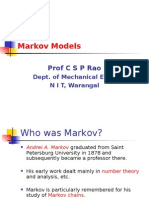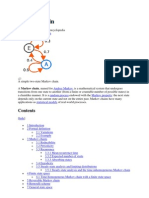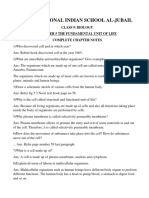HMM
HMM
Uploaded by
Sally JarkasCopyright:
Available Formats
HMM
HMM
Uploaded by
Sally JarkasOriginal Title
Copyright
Available Formats
Share this document
Did you find this document useful?
Is this content inappropriate?
Copyright:
Available Formats
HMM
HMM
Uploaded by
Sally JarkasCopyright:
Available Formats
1
A Markov Model (Markov Chain) is:
similar to a finite-state automata, with probabilities of
transitioning from one state to another:
What is a Markov Model?
S
1
S
5
S
2
S
3
S
4
0.5
0.5 0.3
0.7
0.1
0.9 0.8
0.2
transition from state to state at discrete time
intervals
can only be in 1 state at any given time
1.0
2
Elements of a Markov Model (Chain):
clock
t = {1, 2, 3, T}
N states
Q = {1, 2, 3, N}
the single state j at time t is referred to as q
t
N events
E = {e
1
, e
2
, e
3
, , e
N
}
initial probabilities
j
= P[q
1
= j] 1 j N
transition probabilities
a
ij
= P[q
t
= j | q
t-1
= i] 1 i, j N
What is a Markov Model?
3
A Markov Model (Markov Chain) is:
similar to a finite-state automata, with probabilities of
transitioning from one state to another:
What is a Markov Model?
S
1
S
5
S
2
S
3
S
4
0.5
0.5 0.3
0.7
0.1
0.9 0.8
0.2
transition from state to state at discrete time intervals
can only be in 1 state at any given time
1.0
4
Consider a system described by the following process
At any given time, the system can be in one of possible states =1,2
At regular times, the system undergoes a transition to a new state
Transition between states can be described probabilistically
Markov property
In general, the probability that the system is in state = is a function of
the complete history of the system
To simplify the analysis, however, we will assume that the state of the
system depends only on its immediate past
=|1=,2===|1=
This is known as a first-order Markov Process
We will also assume that the transition probability between any two states is
independent of time ==|1= .. 0 =1=1
Discrete Markov Processes
7
Hidden Markov Model:
more than 1 event associated with each state.
all events have some probability of emitting at each state.
given a sequence of observations, we cant determine exactly
the state sequence.
We can compute the probabilities of different state sequences
given an observation sequence.
Doubly stochastic (probabilities of both emitting events and
transitioning between states); exact state sequence is hidden.
What is a Hidden Markov Model?
8
Elements of a Hidden Markov Model:
clock t = {1, 2, 3, T}
N states Q = {1, 2, 3, N}
M events E = {e
1
, e
2
, e
3
, , e
M
}
initial probabilities
j
= P[q
1
= j] 1 j N
transition probabilities a
ij
= P[q
t
= j | q
t-1
= i] 1 i, j N
observation probabilities b
j
(k)=P[o
t
= e
k
| q
t
= j] 1 k M
b
j
(o
t
)=P[o
t
= e
k
| q
t
= j] 1 k M
A = matrix of a
ij
values, B = set of observation probabilities,
= vector of
j
values.
Entire Model: = (A,B,)
Elements of Hidden Markov Model?
9
HMM Topologies
There are a number of common topologies for HMMs:
Ergodic (fully-connected)
Bakis (left-to-right)
0.3
0.3
0.6 0.2
0.1
0.1
0.6
0.5
0.3
S
1
S
2
S
3
1
= 0.4
2
= 0.2
3
= 0.4
0.3
0.6 0.4
S
1
S
2
1
= 1.0
2
= 0.0
3
= 0.0
4
= 0.0
S
3
0.1
0.4
S
4
1.0
0.9
0.1
0.2
1
0
HMM Topologies
The topology must be specified in advance by the
system
designer
Common use in speech is to have one HMM per
phoneme, and three states per phoneme. Then, the
phoneme-level
HMMs can be connected to form word-level HMMs
1
= 1.0
2
= 0.0
3
= 0.0
0.4
0.6 0.3
A
1
A
2
A
3
0.5
0.7
0.5
0.5 0.2
B
1
B
2
B
3
0.3
0.8 0.4
0.6 0.3
A
1
A
2
A
3
0.5
0.7 0.4
0.6 0.2
T
1
T
2
T
3
4.0
0.8
0.5
0.7
0.5 0.6
HMM generation of observation sequences
The three basic HMM problems
Forward and Backward procedures
The Forward procedure
The Backward procedure
The Viterbi algorithm
The problem with choosing the individually most likely
states is that the overall state sequence may not be valid
Consider a situation where the individually most likely
states are = and +1=, but the transition
probability =0
Instead, and to avoid this problem, it is common to look
for the single best state sequence, at the expense of
having sub-optimal individual states
This is accomplished with the Viterbi algorithm
The Viterbi algorithm
- To find the single best state sequence we define yet
another variable =max12112=,1
2|
which represents the highest probability along a single
path that accounts for the first observations and ends at
state
By induction, +1 can be computed as +1=max
+1
To retrieve the state sequence, we also need to keep
track of the state that maximizes at each time , which
is done by constructing an array +1=arg max1
+1 is the state at time from which a transition to
state maximizes the probability +1
Baum-Welsh re-estimation
Re-estimation procedure
2
5
L
SHOW ALL ALERTS
SH OW AA AX L ER TS
SH SH SH OW OW OW AA AA AA L L L AX AX AX L L L ER ER ER TS TS TS
Example
You might also like
- G9 - Science Test 50 MarksDocument10 pagesG9 - Science Test 50 MarksMazuba ChibbelaNo ratings yet
- Markov ModelsDocument54 pagesMarkov Models225003012No ratings yet
- HiddenMarkovModel FINALDocument73 pagesHiddenMarkovModel FINALTapasKumarDash100% (2)
- Lec-6 HMMDocument63 pagesLec-6 HMMGia ByNo ratings yet
- Hidden Markov ModelsDocument26 pagesHidden Markov ModelsDipta BiswasNo ratings yet
- Hidden Markov ModelDocument32 pagesHidden Markov ModelAnubhab BanerjeeNo ratings yet
- PR l23 PDFDocument23 pagesPR l23 PDFSiddarth JhaNo ratings yet
- Markov ChainsDocument35 pagesMarkov ChainsDavood Pour Yousefian BarfehNo ratings yet
- Markov 123Document108 pagesMarkov 123rafeshNo ratings yet
- Hidden Markov Models and Sequential DataDocument45 pagesHidden Markov Models and Sequential DataSriNo ratings yet
- Markov ChainsDocument63 pagesMarkov Chainsprits92No ratings yet
- Lectures 7 and 8Document37 pagesLectures 7 and 8davyarperNo ratings yet
- Introduction To Hidden Markov ModelsDocument31 pagesIntroduction To Hidden Markov ModelsAnshy SinghNo ratings yet
- Markov ChainsDocument63 pagesMarkov ChainsIbrahim El SharNo ratings yet
- Practice 8Document8 pagesPractice 8Rajmohan AsokanNo ratings yet
- Lecture02 PDFDocument78 pagesLecture02 PDFJimmy Bomfim de JesusNo ratings yet
- PDF Document 3Document80 pagesPDF Document 3Pratyush PurohitNo ratings yet
- What Is The Necessity of HMM ? What Is The Necessity of HMM ?Document55 pagesWhat Is The Necessity of HMM ? What Is The Necessity of HMM ?Ashish GhodkeNo ratings yet
- Markov Chain For Transition ProbabilityDocument29 pagesMarkov Chain For Transition Probabilityalokesh1982100% (1)
- Markov ChainsDocument91 pagesMarkov Chainscreativechand100% (7)
- Markov Chains: Stochastic ModelsDocument7 pagesMarkov Chains: Stochastic Modelsivy_26No ratings yet
- Set3 Markov ChainsDocument50 pagesSet3 Markov ChainsKiran Attal-SakhadevNo ratings yet
- Markov ProcessDocument28 pagesMarkov ProcessSharmaineMirandaNo ratings yet
- HMMDocument24 pagesHMMKaran NarangNo ratings yet
- NE Lecture3 DTMCsDocument26 pagesNE Lecture3 DTMCsgeorgemage7520No ratings yet
- Univariate Time SeriesDocument132 pagesUnivariate Time SeriesWesley Miller Perez OrtizNo ratings yet
- Simulation Based Optimization-1Document73 pagesSimulation Based Optimization-1Ataraxi LeeNo ratings yet
- 1 - Introduction in Dynamical SystemDocument45 pages1 - Introduction in Dynamical SystemMaria ClaytonNo ratings yet
- Markov Chain Monte CarloDocument29 pagesMarkov Chain Monte Carlomurdanetap957No ratings yet
- Markov Chain ModelDocument15 pagesMarkov Chain ModelChinmay PatelNo ratings yet
- Pert15 - Probabilistic Reasoning Over TimeDocument32 pagesPert15 - Probabilistic Reasoning Over Time82gfmcz5fsNo ratings yet
- 5.1 - Analysis Based On State SpaceDocument62 pages5.1 - Analysis Based On State SpaceMarceloNo ratings yet
- Univariate Time Series Modelling and ForecastingDocument72 pagesUnivariate Time Series Modelling and Forecastingjamesburden100% (2)
- Stochastic Process: 1 1 N N 1 N 1 N 1 NDocument12 pagesStochastic Process: 1 1 N N 1 N 1 N 1 NSiva KumarNo ratings yet
- Markov ChainDocument7 pagesMarkov Chainshanigondal126No ratings yet
- Markov ChainDocument16 pagesMarkov Chainnaveenk903No ratings yet
- MarkovChains (Part2)Document23 pagesMarkovChains (Part2)adalinaNo ratings yet
- Module 2Document73 pagesModule 2Christin T.KunjumonNo ratings yet
- Discrete Finite Markov Chains NotesDocument7 pagesDiscrete Finite Markov Chains NotesBENSALEM Mohamed AbderrahmaneNo ratings yet
- 03 DTMC 1+2+3Document81 pages03 DTMC 1+2+3Brandon PeeblesNo ratings yet
- Lecture 11Document55 pagesLecture 11roboganowo24No ratings yet
- Module 5Document51 pagesModule 5Reshma SindhuNo ratings yet
- Markov ChainDocument21 pagesMarkov ChainHENRIKUS HARRY UTOMONo ratings yet
- Unit - 4 Hidden Markov ModelsDocument39 pagesUnit - 4 Hidden Markov Modelsdo7760No ratings yet
- Lecture 3 - 2Document42 pagesLecture 3 - 2faruktokuslu16No ratings yet
- The 'Density Operator': Phy851 Fall 2009Document18 pagesThe 'Density Operator': Phy851 Fall 2009Sammy FlorczakNo ratings yet
- Topic 4 CEM615Document69 pagesTopic 4 CEM615nr.husninathirahNo ratings yet
- AMFE Module 2Document10 pagesAMFE Module 2AruneemaNo ratings yet
- Title: Hidden Markov Model: Hidden Markov Model The States That Were Responsible For Emitting The Various Symbols AreDocument5 pagesTitle: Hidden Markov Model: Hidden Markov Model The States That Were Responsible For Emitting The Various Symbols AreVivek BarsopiaNo ratings yet
- Cellular Automata: An Introduction: Gustavo Camelo NetoDocument24 pagesCellular Automata: An Introduction: Gustavo Camelo NetoGutemberg AlvesNo ratings yet
- Lecture 11Document15 pagesLecture 11theresa.painterNo ratings yet
- May 14Document23 pagesMay 14Danang SutawidjayaNo ratings yet
- State Space RepresentationDocument34 pagesState Space RepresentationMuhammad UsmanNo ratings yet
- Stochastic Process - IntroductionDocument16 pagesStochastic Process - IntroductionRajesh BathijaNo ratings yet
- Markov Chain and Its Applications (Linear Algebra Applications)Document10 pagesMarkov Chain and Its Applications (Linear Algebra Applications)Xinye YangNo ratings yet
- INE 323 - Lecture 22Document36 pagesINE 323 - Lecture 22Nimra Abdul GhaffarNo ratings yet
- Kramer's RuleDocument7 pagesKramer's RuleLurkermanguyNo ratings yet
- Sequence Model:: Hidden Markov ModelsDocument60 pagesSequence Model:: Hidden Markov Models21020641No ratings yet
- ML 5Document28 pagesML 5V Yaswanth Sai 22114242113No ratings yet
- Orientation Jaw RelationDocument42 pagesOrientation Jaw RelationAswitha GanapathyNo ratings yet
- FadingDocument5 pagesFadingAbed Ahmad Al-ZabenNo ratings yet
- Models - Mems.biased Resonator 2d TransientDocument8 pagesModels - Mems.biased Resonator 2d TransientHaris ApriyantoNo ratings yet
- CS 543: Computer Graphics Lecture 4 (Part I) : 3D Affine TransformsDocument26 pagesCS 543: Computer Graphics Lecture 4 (Part I) : 3D Affine TransformsThanasis AnthopoulosNo ratings yet
- What Is Mechanics? Mechanics (: About This CourseDocument3 pagesWhat Is Mechanics? Mechanics (: About This CourseOrlie Regla GallosNo ratings yet
- 3 Vectors and MatricesDocument38 pages3 Vectors and MatricesOreste HernandezNo ratings yet
- Calculations For Short Circuit Withstand Capability of A Distribution Transformer 0976 4860 2 142 150 PDFDocument9 pagesCalculations For Short Circuit Withstand Capability of A Distribution Transformer 0976 4860 2 142 150 PDFsNo ratings yet
- Mexican Hat NetworkDocument10 pagesMexican Hat NetworkSushant Ranade33% (3)
- FDR D Evo Datasheet 12-13-10Document4 pagesFDR D Evo Datasheet 12-13-10Story GottiNo ratings yet
- Assignment 4 - V2Document10 pagesAssignment 4 - V2Kate WoodsNo ratings yet
- Answer Mid Term Programming 2024Document4 pagesAnswer Mid Term Programming 2024ahmedtarek544aNo ratings yet
- Brosur Applied Petrophysics For Geologists and EngineersDocument3 pagesBrosur Applied Petrophysics For Geologists and EngineersHamed SadeghiNo ratings yet
- Core BridgePlugsDocument7 pagesCore BridgePlugsLuiz Alberto Silva SantosNo ratings yet
- 6unit - Optimization Algorithm For Combined Economic and Emission Dispatch With Security ConstraintsDocument4 pages6unit - Optimization Algorithm For Combined Economic and Emission Dispatch With Security ConstraintsDr. B. Srinivasa Rao Professor, EEE DepartmentNo ratings yet
- Crosby - Closed Spelter SocketDocument1 pageCrosby - Closed Spelter SocketRobby VillenaNo ratings yet
- Power Quality: M.Tech. (Integrated Power System / Power Elect. & Power System) Second Semester (C.B.C.S.)Document2 pagesPower Quality: M.Tech. (Integrated Power System / Power Elect. & Power System) Second Semester (C.B.C.S.)Mahesh ShendeNo ratings yet
- Jmeter Scripting Guidelines For This Solution: Injector IdDocument5 pagesJmeter Scripting Guidelines For This Solution: Injector IdRamakrishna GNo ratings yet
- A Guide For Partial Discharge Measurements On Medium Voltage (MV) and High Voltage (HV) ApparatusDocument7 pagesA Guide For Partial Discharge Measurements On Medium Voltage (MV) and High Voltage (HV) ApparatusAmanda MeloNo ratings yet
- HDfury 4 SmanualDocument35 pagesHDfury 4 SmanualAndrew WarrenNo ratings yet
- Problem Statement For B-Tree: Functionalities: InsertionDocument7 pagesProblem Statement For B-Tree: Functionalities: Insertionprek012_686865590No ratings yet
- Problem Solving Session Set 4Document10 pagesProblem Solving Session Set 4Wilson Ernesto Frias FlorezNo ratings yet
- FlashcatUSB ManualDocument26 pagesFlashcatUSB ManualAkshay BawejaNo ratings yet
- 482020104354AM-Class 9 Biology NotesDocument7 pages482020104354AM-Class 9 Biology Noteskmdmohideen2297No ratings yet
- Chapter 21: Multidimensional Scaling and Conjoint Analysis: Advance Marketing ResearchDocument58 pagesChapter 21: Multidimensional Scaling and Conjoint Analysis: Advance Marketing ResearchShachi DesaiNo ratings yet
- Unit - VDocument56 pagesUnit - VJit AggNo ratings yet
- Pdi 5245 GF 13 003 Eng 110Document74 pagesPdi 5245 GF 13 003 Eng 110Scenic777No ratings yet
- Improve Control: Level LoopsDocument8 pagesImprove Control: Level LoopsCraigUnderwoodNo ratings yet
- Tri-Band Digital Pico Repeater: FeaturesDocument3 pagesTri-Band Digital Pico Repeater: FeaturesClaudio CalabreseNo ratings yet
- License LicDocument5 pagesLicense LicHyrul Nizam HamediNo ratings yet

























































































